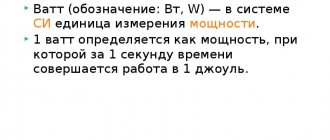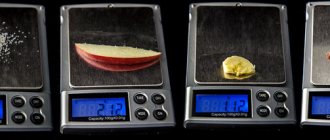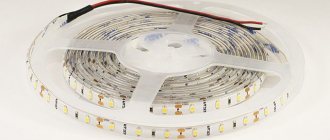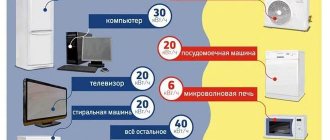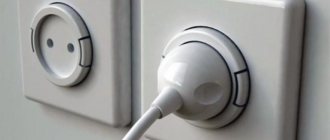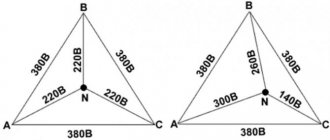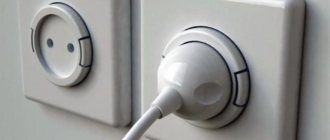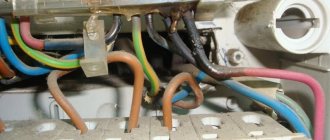Watt and kilowatt - what is it?
A watt is a unit of measurement of power, as well as heat flux in physics, sound electrical flux, direct electric current power, active and apparent electric current power, radiation flux and ionizing radiation energy flux in the international measurement system. It should be noted that this is a scalar measurable quantity, that is, measured and calculated.
Description from link
To make the use of watts convenient, the international system has adopted the use of prefixes that define a decimal multiple of the original indicator. Typically one kilowatt is used for this. Translated from Greek, the prefix kilogram means thousand. Using a prefix means increasing the original value by 103 times.
Note! KWh is a non-systemic unit of measurement that shows when energy is produced or consumed and in what quantity. It also shows the mechanical work performed and the temperature. Used to measure household electricity consumption or to measure electricity production in the energy sector.
Wattmeter device
Current work - how is it measured?
The power of household appliances simultaneously connected to the AC network should not exceed the permissible power of the network. Failure to comply with this condition can lead to overheating of the electrical wiring, failure of technical equipment, short circuit and fire in the room.
Power is determined using a special measuring device - a wattmeter. This device helps:
- control the operation of equipment,
- carry out testing of installations,
- keep track of energy consumption.
In a DC circuit, power is the product of current in amperes and voltage in volts, so no special equipment is required to determine this value.
In an alternating current circuit, power depends on three indicators: voltage, current and the phase shift between them. Therefore, wattmeters are used to determine power in AC networks.
Wattmeters are either analog or digital. Analog instruments can be recording or indicating. The indicator of the indicating wattmeter consists of a semicircular scale and a rotating arrow. The scale is calibrated according to power values in W. The operation of the device is based on the interaction of two inductors. The first, fixedly fixed, with a thick winding, a small number of turns and low resistance. This coil (1) is connected in series with the load (N). The second inductor is movable, with a large number of turns, made of thin copper conductor and high resistance. In the circuit, the coil (2) is connected in parallel to the load (H) together with an additional resistor (R) to prevent a short circuit between the inductances.
When taking measurements, the coils generate magnetic fields, the interaction of which leads to the formation of torque. The moving coil with the arrow deviates at a certain angle. The angle is equal to the product of current and voltage at the current time.
Wattmeter device diagram
Digital wattmeters determine reactive and active power. In addition, the digital screen of the device displays readings of voltage, current, and energy consumption per unit of time.
The operation of a digital wattmeter is based on a preliminary measurement of voltage and current. To do this, a current sensor is installed at the input of the device in series with the load, and a voltage sensor in parallel. The resulting instantaneous values are transmitted to the microcontroller, where the active and reactive components are calculated. The result is displayed on the display or attached external devices.
How to correctly convert these units
A watt is equal to a kilogram per square meter divided by cubic seconds. The prefix kilo means multiply by 1000. The same principle applies to power indicators, that is, 1 kW equals 1000 watts and 1000 volts. This means that 1 unit = 0.001 subunits. That is, if you make a power transfer, a 3 kW electrical appliance will be equal to 3000 W.
You will be wondering what power the 16a machine is designed for
Conversion formula
In electricity
To simplify measurements in electricity, a subblock is used. You can find out how many watts are in kilowatts and convert the units by multiplying watts by 103 and dividing by 1000. To do the reverse conversion, you need to multiply kilowatts by 103 or multiply the known values by 1000.
Amount in electricity
In heating
Joules must be used to measure thermal power. This is the work done by 1 newton per 1 meter. To convert joules to kilowatts, you need to use the joules subunit. 1 kJ contains 0.239 kcal. There are 4.1868 kJ in 1 kcal. 1 kW contains 860 kcal. This means that 1000 kcal is 1163 kW per hour.
Thermal measures
Differences between "kVA" and "kW"
Sometimes on the surface of the device panel or in its description, kVA is used instead of the traditional kW for electrical power. In order for the consumer to be able to determine what value in kVA he needs, he should know that they measure the full value of the quantity, and in kW - the active value.
The total power indicator includes everything that the power source transmits externally, but it is not necessarily completely spent on doing the work. One of its fractions (active) performs work or is transformed into thermal form, the other (reactive) is redirected to the electromagnetic field available in the network. These are different quantities, although they have identical dimensions. In order not to confuse them, volt-amperes, rather than watts, are used to measure the full indicator. The pragmatic meaning of apparent power is that it describes the actual loads created by the consumer on the components of the electrical network. After all, these loads depend on how much current is consumed. Because of this, it is customary to use the volt-ampere value to indicate the power rating of switchboards and transformer devices.
When choosing a power source, it is often not clear to the consumer how much power it can actually provide. This is due to the fact that the technical parameters of such devices record the full power value in VA, and knowledge of how VA and W are related is required.
Converter
You can use an easy to use converter to calculate the values. A converter is a system that converts source data into a given value. All that is required from the user is to enter existing data in the field and click the start button on the service being used.
Note! There are various system converters. Some convert these watts, others directly into kilowatts.
Convector
What is tension? Volt
Voltage is a physical quantity that characterizes the ratio of the work of the electric field in the process of transferring a charge from one point A to another point B to the value of this same charge. Simply put, it is the potential difference between two points. Measured in Volts.
The voltage is essentially similar to the amount of water pressure in the pipe; the higher it is, the faster the water flows from the tap. The voltage is standardized and the same for all apartments, houses and garages, equal to 220 Volts with single-phase power supply. Also allowed according to GOST is a 10 percent deviation for the home electrical network. The voltage must be no less than 198 and no more than 242 Volts.
1 Volt contains:
- 1,000,000 microvolts
- 1,000 millivolts
Conversion table for watt to kilowatt
The measurement values presented in the table below will help you calculate the energy used by a particular device and perform other mathematical calculations in electrical engineering.
Table
In general, kilowatt is a subset of watt, a symbol representing power. You can correctly convert Watts to kW into electricity and heat using the conversion formula, table and special online calculator.
How to convert Amperes to Kilowatts in a three-phase network
Watt = √3 * U * I;
√3 = 1,732;
P = √3 * U * I;
Ampere = W /(√3 * V)
I = P / √3 * U
Task. Calculate the power of a three-phase water heater. When it is operating, the current clamp shows a load of 3.8 A.
P = 1.732 * 380 * 3.8 = 2501
Answer: The power of the water heater is 2.5 kW.
Note. The numbers may be completely different, depending on the heater control circuit.
Let's summarize. Using the above formulas, selecting materials for repair or installation will not be difficult, even for people who do not have an electrical engineering education.
To reinforce the information, watch a video on the topic. It is created a little old-fashioned, but useful and educational.
Also read: Calculation of the power of a three-phase network.
I will end here. Write your questions in the comments. If the article was useful, then click on the social media buttons. Until next time. Bye.
Sincerely, Semak Alexander!
The difference between kilowatt and kilowatt∙hour
In electrical engineering there is a quantity called kilowatt-hour, which is measured by electric meters. Many people substitute concepts, not seeing the difference between the definitions of “kilowatt” and “kilowatt ∙ hour”, considering the values as a parameter.
Despite the similarity of names, these are completely different values. Kilowatt ∙ hour is used to measure the amount of electricity produced or consumed per unit of time. Specifically, the electricity consumption of a 1 kW ∙ hour user indicates the energy consumed by a 1 kW user in 1 hour. Conversely, a kilowatt is a unit of power that indicates the rate at which electricity is produced or consumed.
Example: A recessed LED luminaire is equipped with a 35W LED lamp. For 1 hour of operation it consumes 35 W ∙ hour of electricity, for 2 hours, respectively, 2x35 = 70 W ∙ hour. With continuous operation for 5 days / 120 hours, the power consumption of the lamp will be 35×120 = 4200 W ∙ hour or 4.2 kW ∙ hour.
Value watt-hour or kilowatt-hour
To take into account the consumption of electrical energy, a special device is installed at the entrance of the power cable into the room - an electric meter. Unlike electrical appliances, which are marked as W (W), the meter has a different abbreviation - kW⋅h (kWh), the full name of which is kilowatt-hour.
Counter
The power indicated on a household appliance is the amount of energy consumed in 1 hour. For example, a 2000 W oven for 2 hours of continuous operation, according to the meter readings, will consume 2000 * 2 = 4000 W = 4 kW.
In this way, the consumption of a household device is calculated over a period of continuous operation. If the consumer works intermittently, for example, a refrigerator, this value will be significantly less. Understanding how many watts household appliances consume in total, you can calculate the average consumption for a designated period of time. To calculate the amount to be paid for this period, the resulting value is multiplied by the cost of one kilowatt.
When calculating the volume of electricity consumed, concepts such as kilowatt-hour, watt-hour are used. This is the actual energy consumption of the device in watts or kW for a certain period of time in hours.
Relation to base and multiple units of power
Watt refers to a derived unit of power, so in practice it is sometimes necessary to determine the value of a parameter in relation to the basic units of the international SI system. In technical calculations, the following correspondences to the basic values are used:
- W = kgm²/s³;
- L = Hm/s;
- W=VA
The parameter has universal application and is equally used in technical developments in various fields of activity.
Thermal engineering uses non-SI units to measure heat output in 1 cal/hour. Our considered value is related to it by the ratio: 1 W = 859.85 cal/hour.
Often, for the convenience of working with large power values of power plants and power groups, the word watt can be used with the prefixes “mega” or “giga”:
- megawatt is designated MW/MW and corresponds to 106 W;
- gigawatt (abbreviated GW/GW) is equal to 109 watts.
On the contrary, in low-current information networks, electronic devices and modern electronic equipment, power is measured in fractions of watts:
- milliwatts (mW, mW) – 10-3 W;
- microwatts (μW, μW) are equal to 10-6 W.
Using these ratios, it is always possible to convert most parameters into the required power units.
Power Calculator
Converting power units from one to another
Calculator - Power
In physics, power is the rate at which energy is used, transferred, or converted. The SI unit of power is the watt (symbol "W", after James Watt, who developed the steam engine in the eighteenth century). One Watt is equal to 1 Joule per second (J/s). Power can also be measured in other units, such as horsepower (hp), metric horsepower, ergs per second (Erg/s), and foot-pounds per minute. The term power is different from energy because it is the rate at which energy is changed and expended.
Power unit converter
Translate from
Translate to
W
=
hp
| Basic units | |
| Gigawatt | GW |
| Horsepower | hp |
| Joule per second | J/sec |
| Kilowatt | kW |
| Watt | W |
| Pound-Foot per hour | lb∙ft/h |
| British thermal unit | BTU/h |
| Other units | |
| Attojoule per second | aJ/s |
| Attowatt | aW |
| BTU/Hour (thermochemical) | BTU/h |
| BTU/Minute (international) | BTU/min |
| BTU/Minute (thermochemical) | BTU/min |
| BTU/Second (international) | BTU/s |
| BTU/Second (thermochemical) | BTU/s |
| Calories per hour | cal/h |
| Calories per hour (thermochemical) | cal/h |
| Calories per minute | cal/min |
| Calories per minute | cal/min |
| Calorie/Second (international) | cal/s |
| Calorie/Second (thermochemical) | cal/s |
| Centijoule per second | cJ/s |
| Centiwatt | cW |
| decijoule per second | dJ/s |
| deciwatt | dW |
| Decajoule per second | daJ/s |
| Decawatt | daW |
| Erg per second | erg/s |
| Exajoule per second | EJ/s |
| Exawatt | E.W. |
| Femtojoules per second | fJ/s |
| Femtowatt | fW |
| Gigajoule per second | GJ/s |
| Hectojoule per second | hJ/s |
| Hectowatt | hW |
| Horsepower | hp |
| Horsepower (boiler) | hp |
| Horsepower (electric) | hp |
| Horsepower (UK) | hp |
| Horsepower (water) | hp |
| Joule/Hour | J/h |
| Joule per minute | J/min |
| Kilocalorie hour (thermochemical) | kcal/h |
| Kilocalorie hour (international) | kcal/h |
| Kilocalories per minute (international) | kcal/min |
| Kilocalories per minute (thermochemical) | kcal/min |
| Kilocalories per second (thermochemical) | kcal/s |
| Kilocalories per second (international) | kcal/s |
| Kilojoule per hour | kJ/h |
| Kilojoule per minute | kJ/min |
| Kilojoule per second | kJ/s |
| M.B.H. | |
| MBTU/Hour | MBTU/h |
| Megajoule per second | MJ/s |
| Megawatt | M.W. |
| Microjoule per second | µJ/s |
| Microwatt | µW |
| Millijoule per second | mJ/s |
| Millivat | mW |
| Nanojoule per second | nJ/s |
| Nanovatt | nW |
| Pentajoule per second | PJ/s |
| Petowatt | PW |
| Pferdest | ps |
| Picojoule per second | pJ/s |
| Picowatt | pW |
| Pound-Foot per minute | lb∙ft/min |
| Pound-Foot per second | lb∙ft/s |
| Terrajoule per second | TJ/s |
| Terrawatt | TW |
| Ton (refrigeration) | t |
| Basic units | |
| Gigawatt | GW |
| Horsepower | hp |
| Joule per second | J/sec |
| Kilowatt | kW |
| Watt | W |
| Pound-Foot per hour | lb∙ft/h |
| British thermal unit | BTU/h |
| Other units | |
| Attojoule per second | aJ/s |
| Attowatt | aW |
| BTU/Hour (thermochemical) | BTU/h |
| BTU/Minute (international) | BTU/min |
| BTU/Minute (thermochemical) | BTU/min |
| BTU/Second (international) | BTU/s |
| BTU/Second (thermochemical) | BTU/s |
| Calories per hour | cal/h |
| Calories per hour (thermochemical) | cal/h |
| Calories per minute | cal/min |
| Calories per minute | cal/min |
| Calorie/Second (international) | cal/s |
| Calorie/Second (thermochemical) | cal/s |
| Centijoule per second | cJ/s |
| Centiwatt | cW |
| decijoule per second | dJ/s |
| deciwatt | dW |
| Decajoule per second | daJ/s |
| Decawatt | daW |
| Erg per second | erg/s |
| Exajoule per second | EJ/s |
| Exawatt | E.W. |
| Femtojoules per second | fJ/s |
| Femtowatt | fW |
| Gigajoule per second | GJ/s |
| Hectojoule per second | hJ/s |
| Hectowatt | hW |
| Horsepower | hp |
| Horsepower (boiler) | hp |
| Horsepower (electric) | hp |
| Horsepower (UK) | hp |
| Horsepower (water) | hp |
| Joule/Hour | J/h |
| Joule per minute | J/min |
| Kilocalorie hour (thermochemical) | kcal/h |
| Kilocalorie hour (international) | kcal/h |
| Kilocalories per minute (international) | kcal/min |
| Kilocalories per minute (thermochemical) | kcal/min |
| Kilocalories per second (thermochemical) | kcal/s |
| Kilocalories per second (international) | kcal/s |
| Kilojoule per hour | kJ/h |
| Kilojoule per minute | kJ/min |
| Kilojoule per second | kJ/s |
| M.B.H. | |
| MBTU/Hour | MBTU/h |
| Megajoule per second | MJ/s |
| Megawatt | M.W. |
| Microjoule per second | µJ/s |
| Microwatt | µW |
| Millijoule per second | mJ/s |
| Millivat | mW |
| Nanojoule per second | nJ/s |
| Nanovatt | nW |
| Pentajoule per second | PJ/s |
| Petowatt | PW |
| Pferdest | ps |
| Picojoule per second | pJ/s |
| Picowatt | pW |
| Pound-Foot per minute | lb∙ft/min |
| Pound-Foot per second | lb∙ft/s |
| Terrajoule per second | TJ/s |
| Terrawatt | TW |
| Ton (refrigeration) | t |
Conversion result:
How to calculate the total power of household appliances
The installed power of a house or cottage is important when calculating and choosing electrical wiring and machines. Without this parameter it is impossible to design the power supply of the house.
To find out the installed power, you need to select energy consumption data from the equipment data sheets. For example, as indicated on the license plate.
| Name | Power, W |
| A television | 150 |
| Water heater | 1,500 |
| Electric oven | 2 000 |
| Fixtures (total number of light bulbs throughout the house) | 1,000 |
| Computer | 100 |
| GENERAL: | 3.750 W or 3.75 kW |
To correctly calculate the power supply to a home, the combination coefficient is taken into account. Indicates how many consumers are running at the same time.
For installed power in a house, cottage, apartment up to 14 kW, a coefficient of 0.8 is used in the calculations. That is, the total value of the loads is taken and multiplied by 0.8. For our example, the calculations require a power of 3.75 * 0.8 = 3 kW.
Total power in watts (kilowatts)
To correctly determine the cross-section of the electrical wiring cable and correctly select the rating of the network protective equipment, you need to calculate the total power of energy consumers. This value is obtained by adding the rated power of each consumer.
Important! Before adding up the consumer capacities, you need to convert them into the same unit of measurement: watt or kilowatt. Presumably the following consumers are connected to the network:
Presumably the following consumers are connected to the network:
- 5 lamps 100 W;
- 8 lamps 60 W;
- electric oven 2 kW;
- TV – 100 W;
- refrigerator – 0.3 kW;
- washing machine – 0.6 kW.
The power of lamps and TV is indicated in watts, and the power of ovens, refrigerators and washing machines is indicated in kilowatts. It is necessary to convert kilowatts to watts.
Considering how many watts there are in one kilowatt, we can write that the oven consumes 2 kW. Based on the fact that there are a thousand W in one kW, multiply 2 by 1000, you get 2000 W. The translation for a refrigerator is similar, the result is 300 W. Washing machine – 600 W.
Connection diagram for single-phase receivers
Next, add to 5 lamps 100 W each 8 lamps 60 W, 2000 W oven, 100 W TV, 300 W refrigerator, 600 W washing machine. You get a total figure of 500 W + 480 W + 2000 W + 100 W + 300 W + 600 W =3980 W = 3,980 kW. The result obtained is rounded up to give 4 kW.
Based on the resulting total value, the wire cross-section and automatic protective equipment are calculated.
Converting watts to kW
For example, the iron says 2000 watts (W), this means 2 kW, another example with a 100 W light bulb, when converted to kW we get 0.1 kW, so:
1 kW = 1000 W
By analogy, other meanings can be translated:
You can also convert 1, 2, 3, 4, 5, 6, 7, 8 kW, etc. In watts:
Power (W) Power (kW)
| 1000 | 1 |
| 2000 g | 2 |
| 3000 | 3 |
| 4000 | 4 |
| 5000 | 5 |
| 6000 | 6 |
| 7000 | 7 |
| 8000 | eight |
Where is the power indicated (W and kW)
Manufacturers of electrical consumers indicate the rated power for each product. In this case, the receiver itself is marked, or the data is entered into the technical documentation accompanying it.
For large household consumers, for example, a TV, dishwasher, kitchen hood, the nominal value in W or kW is applied to the rear or front panel and duplicated in the technical documentation.
Markings on the kitchen hood
Marking of incandescent lamps (40 W, 60 W, 100 W, 150 W, 500 W) is applied to the glass bulb and cardboard packaging. The same indicator for an iron, hair dryer, or heater is indicated on their body.
Current and power
To determine what power electrical appliances can be connected to the network, you need to know 2 parameters - voltage and current that the fuse or socket can withstand. There are usually no problems with tension. The most commonly used are 220 V (in apartments and for loads less than 15 kW), 380 V (in industrial enterprises) or 12 V (in a car).
The most commonly used current values and their corresponding power can be found in the table below.
Converting from Amperes to kilowatts using a table is not difficult: in the first column you need to find the current strength indicated on the machine or fuse, then select the required voltage in the first line, find the cell at the intersection of the line with the current strength and the column with the voltage.
For example, the maximum current that an outlet in an apartment is designed for is 16 A. The network voltage is 220 V. Accordingly, the maximum load that this outlet can withstand is 3.52 kW. This means that you can easily connect a TV, iron or hair dryer to it. However, connecting a boiler with a power of 6 kW to it will lead to the fact that the outlet will begin to melt and may even catch fire.
What to do if the required current value is not presented in the table? You should calculate it yourself using a simple formula: P = IU, where P is power, I is current, U is network voltage. It can also be used in a situation where the power of an electrical appliance is known, and the current strength needs to be determined for it. In this case, the formula is transformed into the following relationship: I = P/U.
Let's consider this example. An oven with a power of 2000 W was purchased. Can I plug it into a 10A outlet? Since houses usually use a voltage of 220 V, we perform the calculation as follows: I = 2000/220 = 9.09 A. Since we received a value that does not exceed the maximum permissible, we conclude that using such an outlet to connect an oven it is possible, but only if the condition of the outlet and wiring in the house is good.
